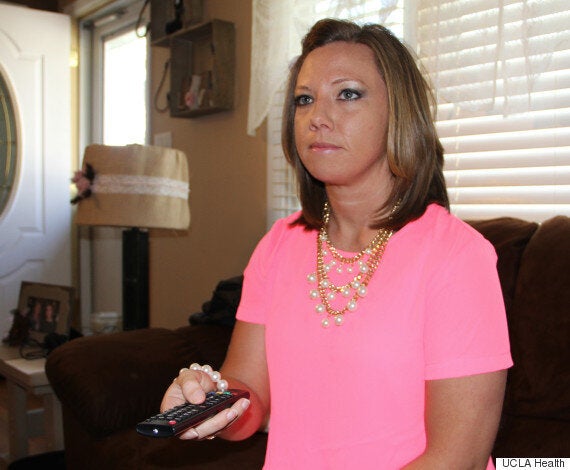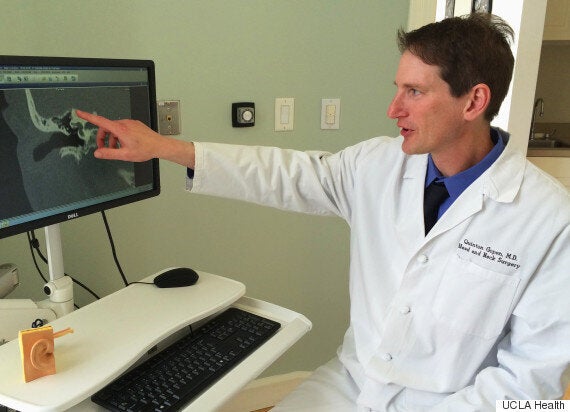When Rachel Pyne turned 27, she was shocked to find she could hear all of her internal bodily noises.
"There were times where my eyeballs sounded like scratching on a chalkboard," she tells HuffPost UK Lifestyle. "I was dizzy, I had brain fog constantly, my voice sounded like a kazoo in my ears, and I could hear my heartbeat all day long.
"Just the slightest noise would make me extremely dizzy, whether that was jingling keys, car horns, cash register beeps, crinkling chip bags, the sound of the road while driving my car, water in the shower or even chewing my food."
It was a living nightmare.

Rachel Pyne
Pyne experienced the first major symptoms of Superior Semi-circular Canal Dehiscence (SSCD) in March 2014.
"I think I've had some of my symptoms ever since I can remember," she admits. "I've heard my heartbeat my entire life, I never knew that wasn't normal. I also always had a sensitivity to noise."
SSCD is a rare disorder caused by a tiny hole in the bone encasing the inner ear.
According to Dr Quinton Gopen, ear surgeon at Ronald Reagan UCLA Medical Center, the hole amplifies the body’s sounds directly into the ear, which constantly bombards patients with noises they wouldn’t ordinarily hear - like their eyes moving, heart beating, footsteps reverberating and food digesting.
"The patient’s own voice echoes inside their head," he says, "prompting a lot of patients to isolate themselves and stop talking. The condition makes the patient extra sensitive to noises and can cause hearing loss and severe vertigo, nausea and balance problems.
"In short, it disrupts a person’s daily life and can be completely debilitating."
SEE ALSO:
Woman Left Bedbound By Tiny Hole In Ear Reveals How It's 'Impossible' To Lead An Ordinary Life
Rare Medical Condition Is Causing This Woman To Starve To Death
For Pyne, because her condition was so rare, it took several months to get a diagnosis.
"I saw specialists in Chicago, Indianapolis, Baltimore, Boston, Los Angeles, and several local doctors as well," she explains. "No one was able to help."
Most of the time, doctors would send her home with a migraine diagnosis but no treatment plans. "One doctor told me I just needed to learn to live with it," she adds.
Her SSCD had worsened to the point where it affected every aspect of her life.
"I've never been through a harder time," she explains. "I had to stop all social activities. I had to put a hold on my passion for photography. I had to work as little as possible - just enough to cover the bills."
As soon as she'd come home from work, Pyne would go straight to bed where her head would spin constantly until she managed to fall asleep. "I couldn't watch TV. I couldn't listen to music. I got to the point where I couldn't even go into a grocery store anymore.
"I could barely even take showers," she adds. "I would fall nearly every night in the shower."
When she approached doctors at Ronald Reagan UCLA Medical Center, Pyne was at wit's end. But, much to her delight, she was given a diagnosis almost immediately.
"As soon as I was all finished talking, Dr Gopen told me I had SSCD and told me he would do the surgery for me," she says. "I was in tears! No doctor had ever just listened to me like that. It was very validating."
Story continues below...
According to Dr Gopen, the Ronald Reagan UCLA Medical Center has treated more than 100 SSCD patients over the past four years.
"We estimate that SSCD affects about one in half a million patients, however the number may be higher," he says.
"Because the syndrome wasn’t discovered until the 1990s, many physicians are not familiar with the symptoms and some patients suffer for months and years without a diagnosis.
"Most patients are middle-aged or older, however, I have treated patients as young as 14."

Dr Quinton Gopen points out tiny holes that developed between the inner ear and the brain of a patient
Pyne admits she was more excited than nervous for the surgery. "I couldn't live with this condition any longer," she says. "To me, brain surgery was my only option."
The surgery involved drilling into the bone above Rachel's ear, and lifting the brain away from the skull.
"This enabled me to access the space between the ear and skull and plug the minuscule hole in her inner ear with an artificial filler called bone wax," says Dr Goben.
Amazingly, the entire procedure lasted 90 minutes and when Rachel woke up, she noticed the difference straight away.
"I had a clear head, I didn't feel any spinning and that's when I knew... It was gone. I couldn't stop thanking my surgeons.
"It was probably the happiest day of my life."